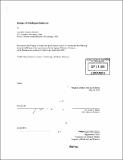| dc.contributor.advisor | Edwin J. Selker. | en_US |
| dc.contributor.author | Bonanni, Leonardo Amerigo, 1977- | en_US |
| dc.contributor.other | Massachusetts Institute of Technology. Dept. of Architecture. Program In Media Arts and Sciences | en_US |
| dc.date.accessioned | 2006-08-25T18:54:42Z | |
| dc.date.available | 2006-08-25T18:54:42Z | |
| dc.date.copyright | 2005 | en_US |
| dc.date.issued | 2005 | en_US |
| dc.identifier.uri | http://hdl.handle.net/1721.1/33895 | |
| dc.description | Thesis (S.M.)--Massachusetts Institute of Technology, School of Architecture and Planning, Program in Media Arts and Sciences, 2005. | en_US |
| dc.description | Includes bibliographical references. | en_US |
| dc.description.abstract | Ubiquitous computing is transforming interior design by allowing utilities, goods and information to be delivered where and when we need them. How will new information technologies impact the design of interior spaces? Intelligent interiors can be more flexible and expressive than traditional spaces. Automation, personal fabrication and augmented reality can be applied to interior spaces with new interaction modes that operate at an architectural scale. Water, light, and other utilities can be automated in a way that empowers users by providing direct feedback, tangible benefit and being fail-soft. Appliances can make it possible to produce and recycle a large number of variable goods locally and on demand. Many of the objects and surfaces of interior spaces can serve as displays to provide information intuitively where and when it is needed. This thesis demonstrates how distributed intelligence can increase productivity and enrich the experience of interior spaces. Experiments with augmentations to the utilities, goods and information of a working kitchen suggest guidelines for interaction with intelligent interior spaces. The perceptual load and quality of interaction needs to be balanced; for example in our experiments projected text was almost always distracting. | en_US |
| dc.description.abstract | (cont.) This work demonstrated that: information should behave at the scale of architectural space; an intelligent interior space should provide as much fidelity at the lowest bandwidth possible to support activity without distracting from tasks; the association of information to the tasks and objects referred to should be concrete and obvious; and appropriate feedback should accompany new interaction to increase the control and confidence of users. This thesis shows that new interaction modes for interior spaces can be intuitively understood and valued. In addition to being more flexible and functional, intelligent interiors can enrich everyday activity with new sensory experiences. | en_US |
| dc.description.statementofresponsibility | by Leonardo Amerigo Bonanni. | en_US |
| dc.format.extent | 112 p. | en_US |
| dc.format.extent | 5131962 bytes | |
| dc.format.extent | 5136561 bytes | |
| dc.format.mimetype | application/pdf | |
| dc.format.mimetype | application/pdf | |
| dc.language.iso | eng | en_US |
| dc.publisher | Massachusetts Institute of Technology | en_US |
| dc.rights | M.I.T. theses are protected by copyright. They may be viewed from this source for any purpose, but reproduction or distribution in any format is prohibited without written permission. See provided URL for inquiries about permission. | en_US |
| dc.rights.uri | http://dspace.mit.edu/handle/1721.1/7582 | |
| dc.subject | Architecture. Program In Media Arts and Sciences | en_US |
| dc.title | Design of intelligent interiors | en_US |
| dc.type | Thesis | en_US |
| dc.description.degree | S.M. | en_US |
| dc.contributor.department | Program in Media Arts and Sciences (Massachusetts Institute of Technology) | |
| dc.identifier.oclc | 66528388 | en_US |
